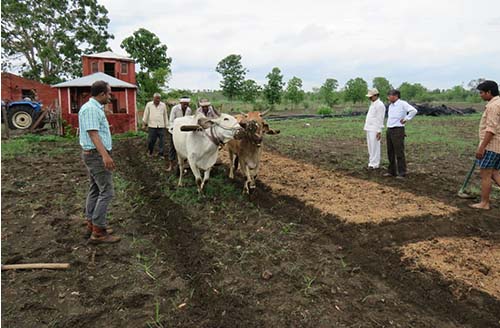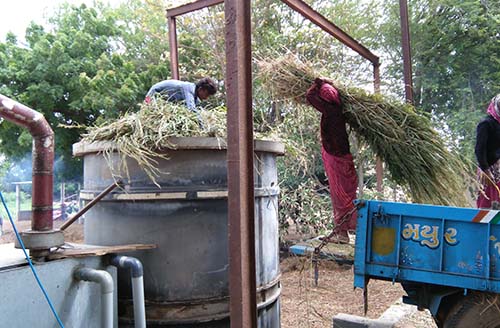PRC1, CIM-Harsh
PRC1 (CSIR-CIMAP)
CIM-Harsh (CSIR-CIMAP)
Cymbopogon martinii (Palmarosa) is widely cultivated for its aromatic oil. The essential oil of this plant, which contains the chemical compound geraniol, is valued for its scent and for a number of traditional medicinal and household uses. Palmarosa oil, which has a scent similar to roses, is also added to soaps and cosmetics. Palmarosa is generally grown in a nursery in a soil of pH of 7-8. Two or three days before planting, it is desirable to irrigate the soil to increase soil moisture above 60% before planting the seeds. Palmarosa grows well in sandy texture soil with low nitrogen, sufficient phosphorus and potassium. This crop grows slowly, taking three months to flower; once it has flowered, it can be harvested. It can be harvested three to four times a year. Under irrigated conditions, oil yield of 120-150 kg/ha/year and in un-irrigated conditions 80 kg/ha/year can be obtained.
Palmarosa thrives well in tropical and humid climatic conditions. A clear warm weather with low relative humidity is necessary for optimum growth in north Indian climate. This crop can be cultivated at elevation up to 300 meters. The annual rainfall required is about 100 to 150 cm. The ideal temperature of 15°C to 38°C results in good growth of the grass. Palmarosa grass is sensitive to frost conditions, so avoid frost-prone areas for its cultivation.
Palmarosa grass can be grown in wide range of soils from poor sandy loam to heavy fertile soils. However, it thrives best in well-drained sandy loam. It requires an annual rainfall of 150 cm. However, water logging will result in poor yield resulting in less oil and may also prove fatal to the plant. The ideal pH range for its cultivation is 6.5 to 7.5. This plant can tolerate pH up to 9.5. Palmarosa can grow up well in non-irrigated and non-productive soil as well.
propagated through seeds. 5-6 kg seeds with >80% germination is required for 1 ha. In broadcasting method, 10-12 kg seed is required for 1 ha. Nursery for 1 ha can be raised in 100m. After 2-3 ploughing, field is ready for transplantation of nursery in normal condition with spacing of 60 x 30 cm and in non-irrigated condition, spacing of 30 x 30 cm is ideal.
In irrigated condition, 150:50:50 kg NPK is required per ha per year, Nitrogen applied after every harvesting. Half the doses of fertilizers are required in non-irrigated condition.
First irrigation is applied just after transplanting. If rainfall then there is no need of irrigation. The water requirement is less for this crop. In winter and summer season, 3-4 irrigation is sufficient. However, irrigation must follow every harvesting.
Palmarosa harvested about 4-6" above the ground with 50% flowering stage. In rainy season harvesting can be done without flowering. In irrigated conditions, 3-4 harvests and in non-irrigated conditions two harvests can be taken in a year.
Floral shoots and above ground parts of the plant are used for distillation of essential oil.
Cost of cultivation : Rs. 40,000/ha/yr (Irrigated), Rs. 30,000/ha/yr (Un-irrigated)
Gross return : Rs. 1,60,000/ha/yr (Irrigated), Rs. 1,00,000/ha/yr (Un-irrigated)
Net profit : Rs. 1,20,000/ha/yr (Irrigated), Rs. 70,000/ha/yr (Un-irrigated)




